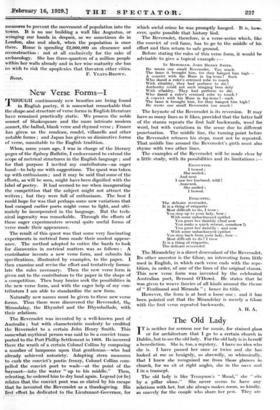New Verse Forms—I T HOUGH continuously new beauties are being found
in English poetry, it is somewhat remarkable that the shape and structure of verse forms in English literature have remained practically .static. We possess the noble sonnet of Shakespeare and the more intricate modern sonnet, the ballad, blank verse and rhymed verse ; France has given us the .rondeau, rondel, villanelle and other notable forms ; and Japan has given us diminutive forms of verse, unsuitable to the English tradition.
When; some years ago, I was in charge of the literary .pages of the Sydney Bulletin, I endeavoured to extend the scope of metrical structures in the English language ; and for that purpose I invited my contributors—an eager band—to help me with suggestions. The quest was taken up with enthusiasm ; and it may be said that some of the efforts, as will be seen, might have been dignified with the label of poetry. It had seemed to me when inaugurating the competition that the subject might not attract the writers ; but they were full of enthusiasm. The best I could hope for was that perhaps some new variations that had escaped earlier poets might-come to light, and ulti- mately be incorporated in the language. But the tech- nical ingenuity was remarkable. Through the efforts of these- eager experimenters several quite useful forms of verse made their appearance.
The result of this quest was that some very fascinating .experiments in metrical form made their-modest appear- ance.- The method adopted to entice the bards to look for discoveries in metrical matters was as follows : A contributor invents a new verse form, and submits his 'specifications, illustrated 'by examples, to the paper. I then examine and revise the effort and tentatively formu- late the rules necessary. Then the new verse form is given out to the contributors to the paper in the shape of a competition. Then busy brains seek the possibilities in the new verse form, and with the eager help of my con- tributors I -am -able to standardize the new form.
Naturally new names must be given to these new verse forms. Thus there were discovered the Reversolet, the Mirandalay, the Rhymbel and the Rhymballade, with their relations.
The Reversolet was invented by a well-known poet of Australia ; but with characteristic modesty he credited the Reversolet to a certain John Henry Smith. This somewhat mythical person was said to be a convict trans- ported to the Port Phillip Settlement in 1808. He incurred there the wrath of a certain Colonel Collins by composing a number of lampoons upon that gentleman—who had already achieved notoriety. Adopting stern measures to curb the convict's poetic frenzy, Colonel Collins com- pelled the convict poet to wade—at the point of the bayonet—into the water " up to his middle." Then, relenting, he ordered him to dry land again. Legend (or lie) relates that_the convict poet was so elated by his escape that he invented the Reversolet as a thanksgiving. His first effort he dedicated to the Lieutenant-Governor, for _which awful crime he was promptly- hanged. It is, how. .ever, quite possible that- history lied.
The Reversolet, therefore, is a verse-series which, like the convict of evil fame, has to go to the middle of his .effort and then return to safe ground.
. Before stating the rules of this verse form, it would be advisable to _give a topical example :— Is MEMORIAM, JOHN HENRY Stara.
He wrote. oue small Reversolet. Too much
The fame it brought him, for they hinged him high—
A convict with his Muse in leg-irons ! Such
Who dared a ruler's, ermined robe to touch
With ribaldry, they had perforce to die I Authority could not such stinging bees defy With ribaldry. .They- had perforce to die. Who dared a ruler's ermined robe to touch ?
'A convict with his Muse in leg-irons !—such The fame it brought him, for they hanged him high ! He wrote one small Reversolet too much !
- The keynote of the.Reversolet is its reversion. It may have as many lines as it likes, provided that the latter half of the stanza repeats the first half backwards, word for word, but with variations in the sense due to different -punctuation. The middle line, the turning point before the Reversolet retraces his steps, must not be repeated. That middle line around the Reversolet's girth must also -rhyme with two other lines.
The examples. of the Reversolet will' be made clear by a little study, with its possibilities and its limitations ;— ENCOUNTER.
I. bowed ; _ She smiled ; And neat I saw her husband, wild !
Annexed, She smiled ; I 'bowed.
ETIQUETTE.
The delicate reversolet, It is a thing of etiquette Most difficult to do, I trow You step up to your lady, bow ; With some =hackneyed epithet You greet her daintily (And now You make a quick retreat, somehow !) You greet her daintily : and now With some unhackneyed epithet
You step back from your lady, bow—
Most difficult to do ! I trow It is a thing of etiquette, The delicate reversolet!
The Mirandelay is a direct descendant of the Reversolet. Its other ancestor is the Glose, an interesting form little used in English, in which each verse ends with the repe- tition in order, of one of the lines of the original stanza. -This new verse form was invented by the celebrated Australian poet, Bernard O'Dowd. He states that he was given to weave fancies of all kinds around the theme of " Ferdinand and Miranda "-; hence its title. - However, the form is at best a loose one ; and it has been pointed out that the Mirandelay is merely a Glose with the first verse repeated backwards.
A. H. A.










































 Previous page
Previous page